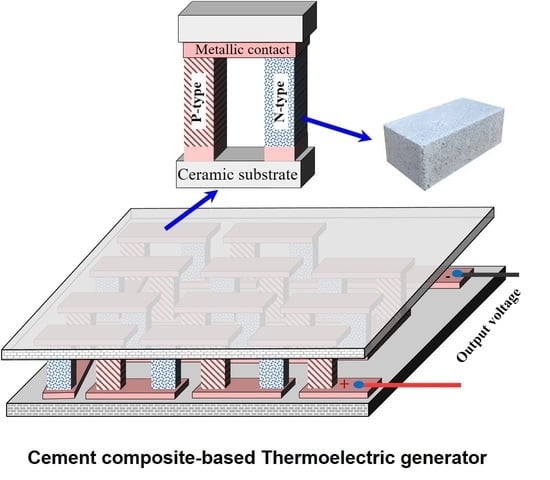Estimation of Energy Harvesting by Thermoelectric Cement Composites with Nanostructured Graphene and Metallic Oxides
Abstract
:1. Introduction
2. Materials and Methods
2.1. Sample Preparation
2.2. Thermodynamics of a Thermoelectric Generator
3. Results and Discussion
3.1. Thermoelectric Properties
3.2. Analysis of Maximum Electrical Power Output
3.3. Analysis of Open-Circuit Voltage
3.4. Analysis of Energy Conversion Efficiency
3.5. Possible Uses of Thermoelectric Cement Composite
4. Conclusions
Author Contributions
Funding
Data Availability Statement
Acknowledgments
Conflicts of Interest
References
- Liu, Z.; Zhang, L.; Gong, G.; Li, H.; Tang, G. Review of solar thermoelectric cooling technologies for use in zero energy buildings. Energy Build. 2015, 102, 207–216. [Google Scholar] [CrossRef]
- Kim, Y.; Ramousse, J.; Fraisse, G.; Dalicieux, P.; Baranek, P. Optimal sizing of a thermoelectric heat pump (THP) for heating energy-efficient buildings. Energy Build. 2014, 70, 106–116. [Google Scholar] [CrossRef]
- Černý, R.; Němečková, J.; Rovnanikova, P.; Bayer, P. Effect of thermal decomposition processes on the thermal properties of carbon fiber reinforced cement composites in high-temperature range. J. Therm. Anal. Calorim. 2007, 90, 475–488. [Google Scholar] [CrossRef]
- Sakane, S.; Ishibe, T.; Taniguchi, T.; Naruse, N.; Mera, Y.; Fujita, T.; Alam, M.; Sawano, K.; Mori, N.; Nakamura, Y. Thermoelectric power factor enhancement based on carrier transport physics in ultimately phonon-controlled Si nanostructures. Mater. Today Energy 2019, 13, 56–63. [Google Scholar] [CrossRef]
- Wei, J.; Zhao, L.; Zhang, Q.; Nie, Z.; Hao, L. Enhanced thermoelectric properties of cement-based composites with expanded graphite for climate adaptation and large-scale energy harvesting. Energy Build. 2018, 159, 66–74. [Google Scholar] [CrossRef]
- Wei, J.; Fan, Y.; Zhao, L.; Xue, F.; Hao, L.; Zhang, Q. Thermoelectric properties of carbon nanotube reinforced cement-based composites fabricated by compression shear. Ceram. Int. 2018, 44, 5829–5833. [Google Scholar] [CrossRef]
- Tzounis, L.; Liebscher, M.; Fuge, R.; Leonhardt, A.; Mechtcherine, V. P- and n-type thermoelectric cement composites with CVD grown p- and n-doped carbon nanotubes: Demonstration of a structural thermoelectric generator. Energy Build. 2019, 191, 151–163. [Google Scholar] [CrossRef]
- Ghosh, S.; Harish, S.; Rocky, K.A.; Ohtaki, M.; Saha, B.B. Graphene enhanced thermoelectric properties of cement based composites for building energy harvesting. Energy Build. 2019, 202, 109419. [Google Scholar] [CrossRef]
- Wei, J.; Zhang, Q.; Zhao, L.; Hao, L.; Yang, C. Enhanced thermoelectric properties of carbon fiber reinforced cement composites. Ceram. Int. 2016, 42, 11568–11573. [Google Scholar] [CrossRef]
- Ji, T.; Zhang, X.; Zhang, X.; Zhang, Y.; Li, W. Effect of Manganese Dioxide Nanorods on the Thermoelectric Properties of Cement Composites. J. Mater. Civ. Eng. 2018, 30, 04018224. [Google Scholar] [CrossRef]
- Ji, T.; Zhang, X.; Li, W. Enhanced thermoelectric effect of cement composite by addition of metallic oxide nanopowders for energy harvesting in buildings. Constr. Build. Mater. 2016, 115, 576–581. [Google Scholar] [CrossRef]
- Ghosh, S.; Harish, S.; Ohtaki, M.; Saha, B.B. Enhanced figure of merit of cement composites with graphene and ZnO nanoinclusions for efficient energy harvesting in buildings. Energy 2020, 198, 117396. [Google Scholar] [CrossRef]
- Ghosh, S.; Harish, S.; Ohtaki, M.; Saha, B.B. Enhanced Thermoelectric Figure of Merit in Cement Composites with Graphene and Metallic Oxide Hybrid Nanostructures. Mater. Today Energy 2020, 18, 100492. [Google Scholar] [CrossRef]
- Snyder, G.J. Small Thermoelectric Generators. Electrochem. Soc. Interface 2008, 17, 54–56. [Google Scholar] [CrossRef]
- Champier, D.; Bédécarrats, J.; Kousksou, T.; Rivaletto, M.; Strub, F.; Pignolet, P. Study of a TE (thermoelectric) generator incorporated in a multifunction wood stove. Energy 2011, 36, 1518–1526. [Google Scholar] [CrossRef]
- Champier, D.; Bedecarrats, J.; Rivaletto, M.; Strub, F. Thermoelectric power generation from biomass cook stoves. Energy 2010, 35, 935–942. [Google Scholar] [CrossRef]
- Karl, H.; Andreas, W.; Adam, W. Wireless Sensor Networks; Goos, G., Hartmanis, J., van Leeuwen, J., Eds.; 1st Eur. Work. EWSN; Springer: Berlin/Heidelberg, Germany, 2004. [Google Scholar]
- Knight, C.; Davidson, J.; Behrens, S. Energy Options for Wireless Sensor Nodes. Sensors 2008, 8, 8037–8066. [Google Scholar] [CrossRef]
- Settaluri, K.T.; Lo, H.; Ram, R.J. Thin Thermoelectric Generator System for Body Energy Harvesting. J. Electron. Mater. 2011, 41, 984–988. [Google Scholar] [CrossRef]
- Wen, S.; Chung, D. Cement-based thermocouples. Cem. Concr. Res. 2001, 31, 507–510. [Google Scholar] [CrossRef]
- Converter VS-U. Available online: https://www.analog.com/media/en/technical-documentation/data-sheets/LTC3108.pdf (accessed on 8 May 2020).
- Wei, Q.; Mukaida, M.; Kirihara, K.; Naitoh, Y.; Ishida, T. Polymer thermoelectric modules screen-printed on paper. RSC Adv. 2014, 4, 28802–28806. [Google Scholar] [CrossRef]
- Shi, Y.; Wang, Y.; Deng, Y.; Gao, H.; Lin, Z.; Zhu, W.; Ye, H. A novel self-powered wireless temperature sensor based on thermoelectric generators. Energy Convers. Manag. 2014, 80, 110–116. [Google Scholar] [CrossRef]
- Lu, X.; Yang, S.H. Thermal energy harvesting for WSNs. In Proceedings of the 2010 IEEE International Conference on Systems, Man and Cybernetics, Istanbul, Turkey, 10–13 October 2010; pp. 3045–3052. [Google Scholar]
- Liu, Z.B.; Zhang, L.; Gong, G.; Luo, Y.; Meng, F. Experimental study and performance analysis of a solar thermoelectric air conditioner with hot water supply. Energy Build. 2015, 86, 619–625. [Google Scholar] [CrossRef]
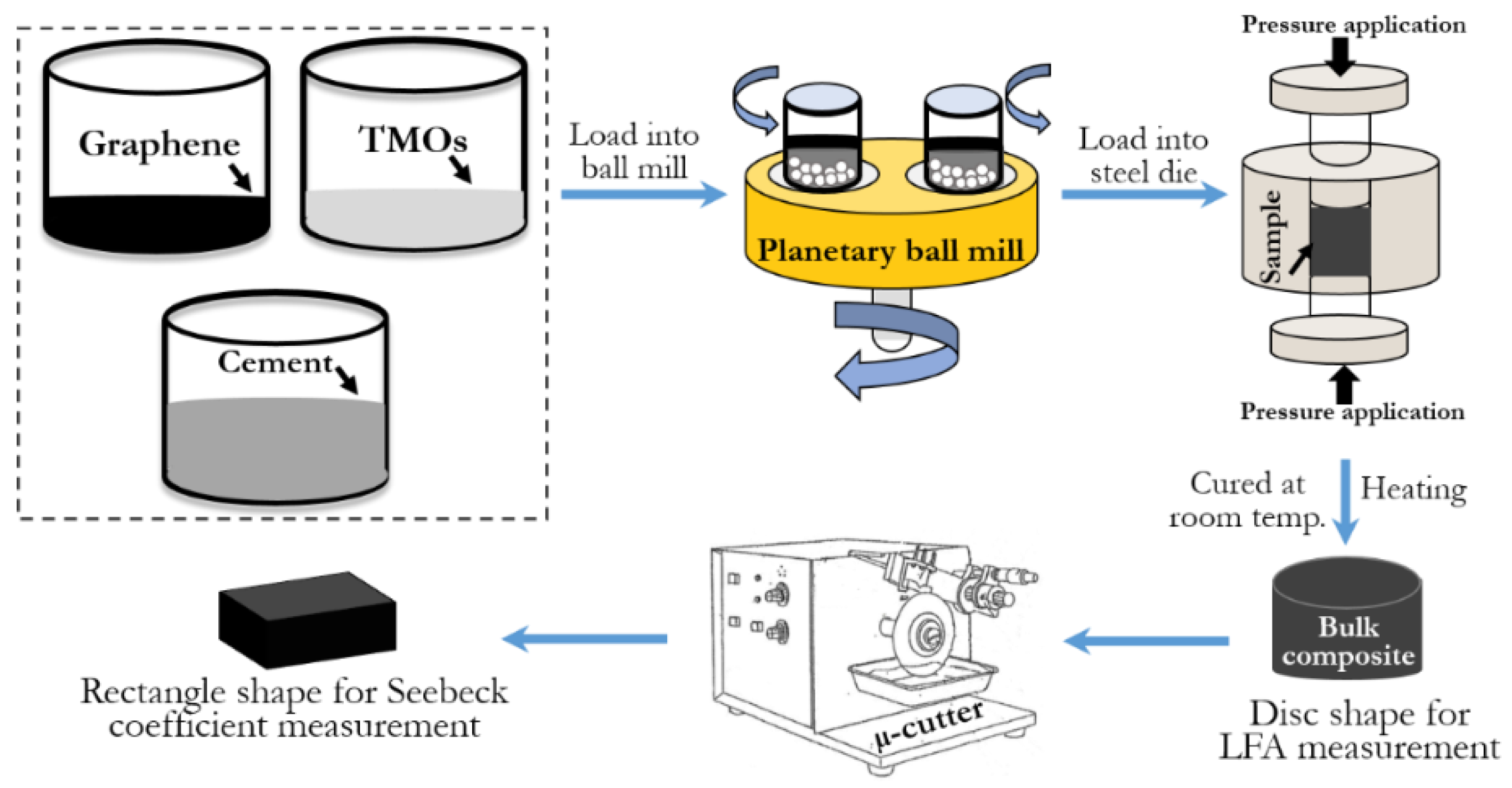

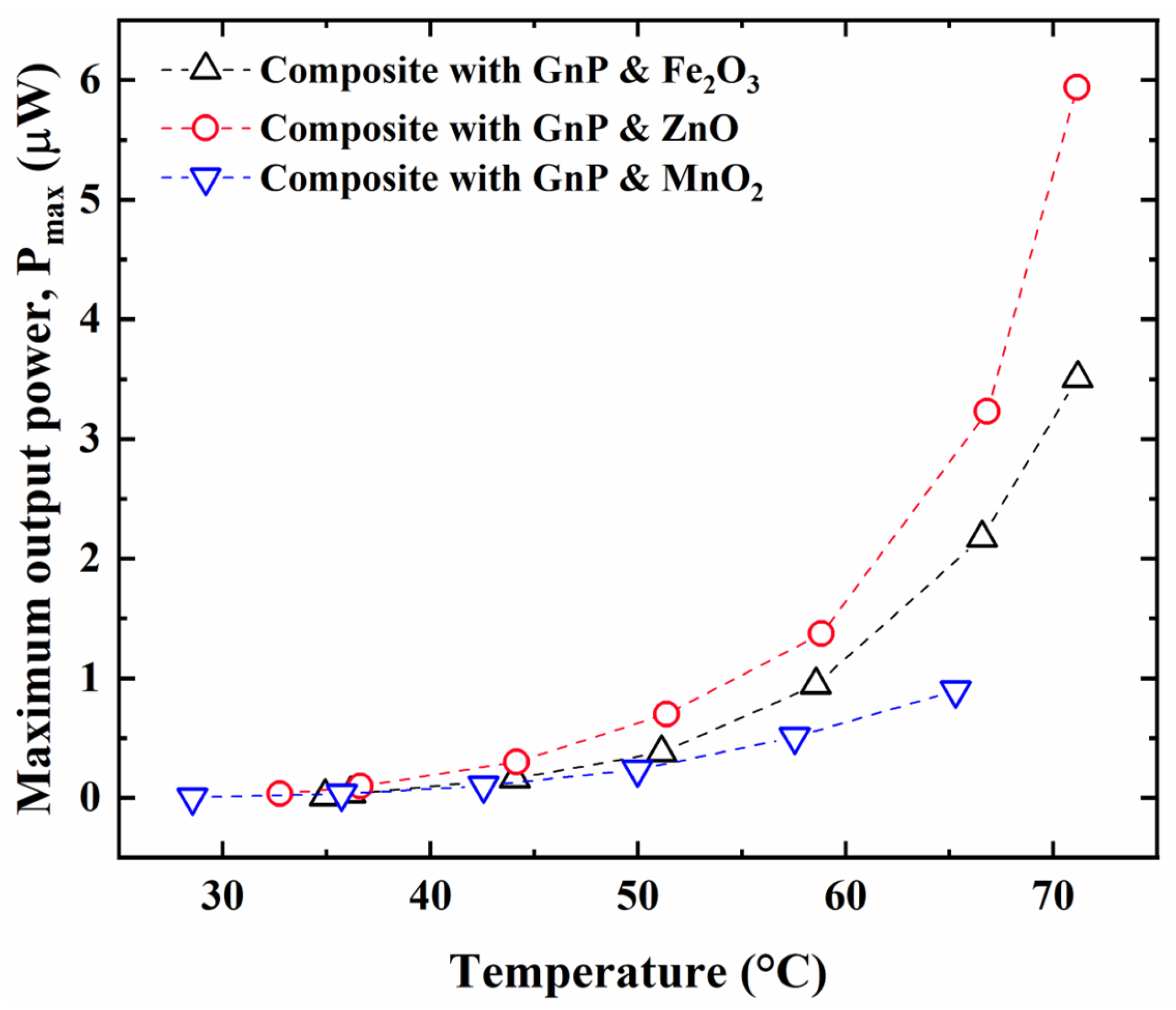
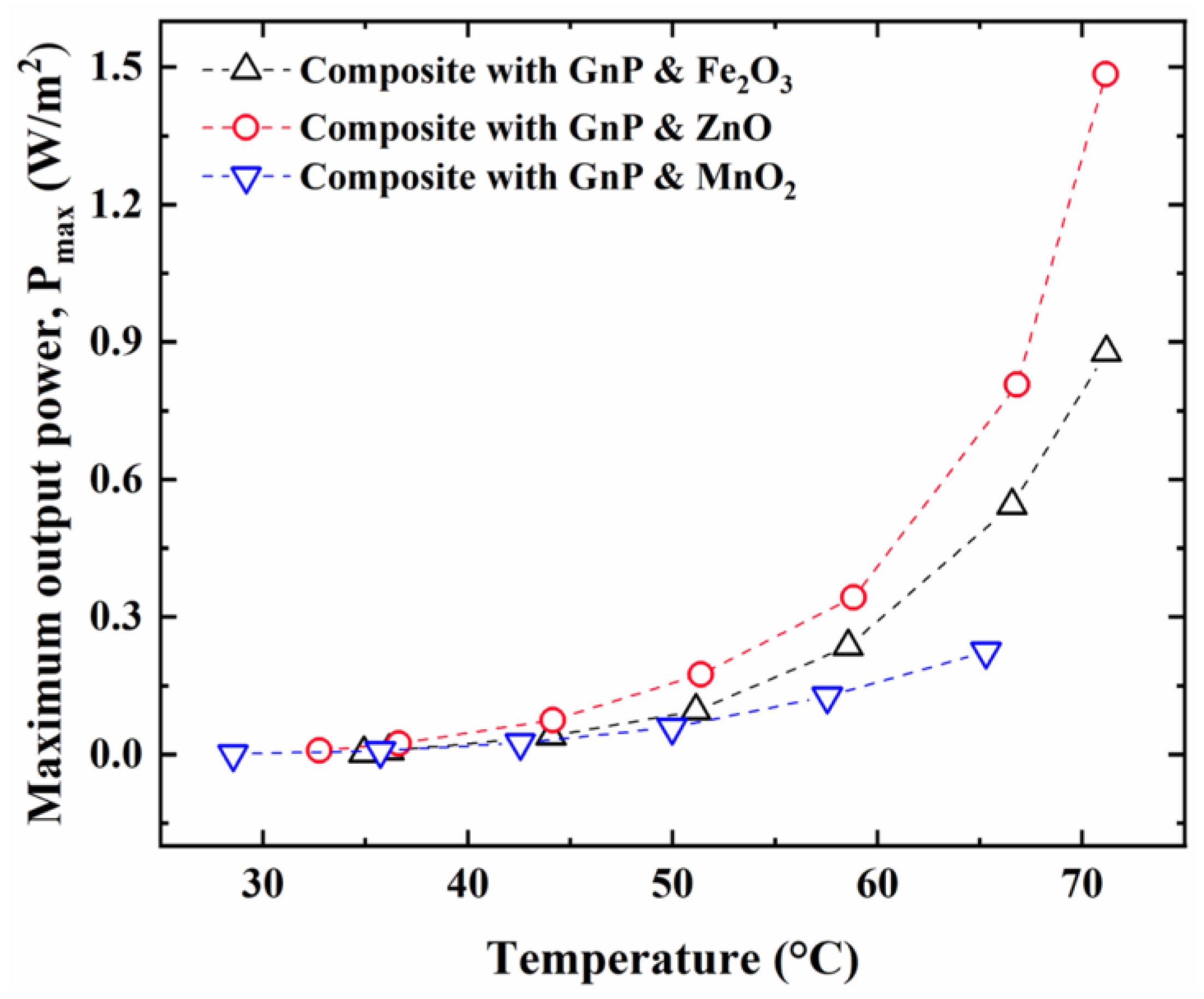
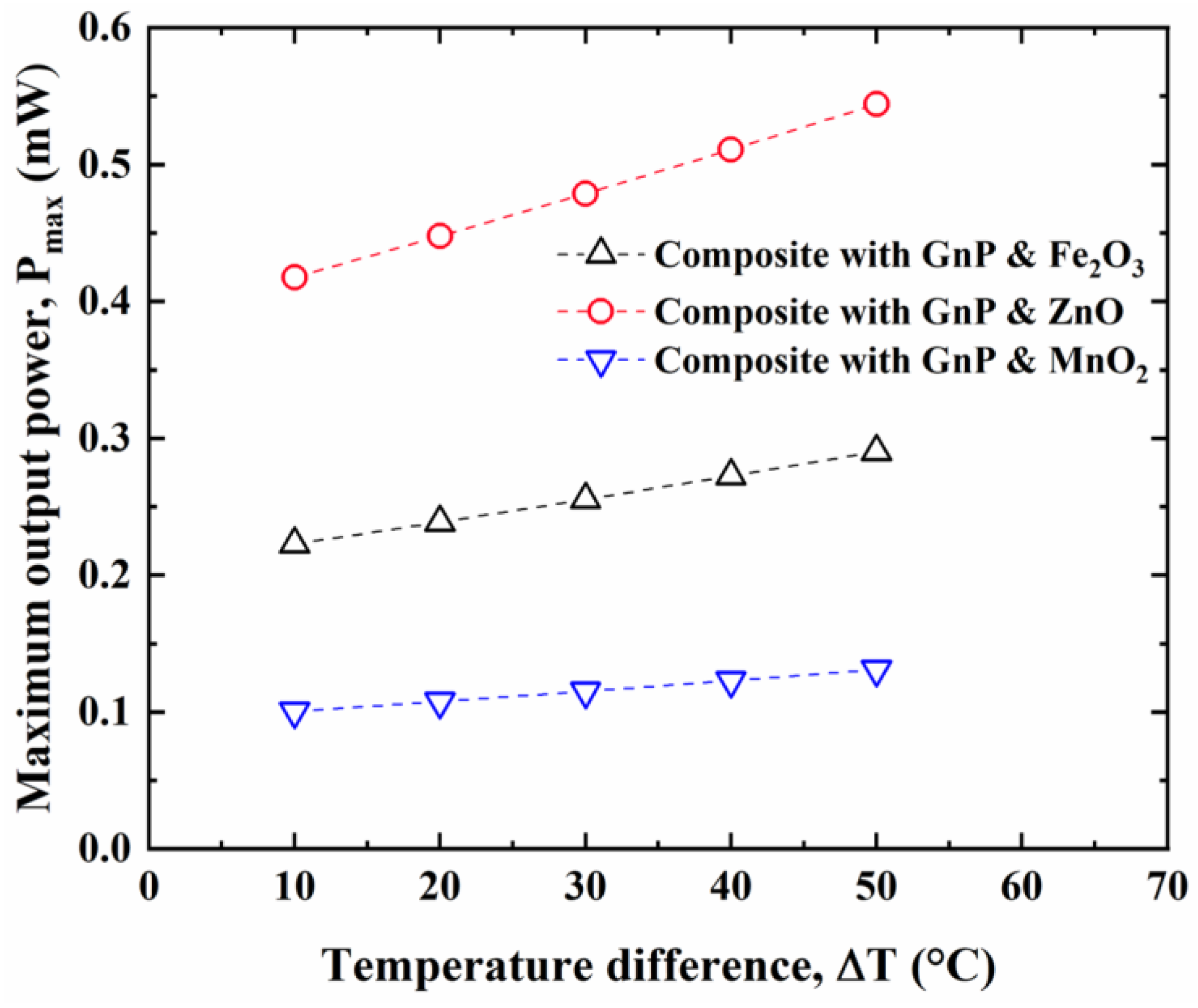
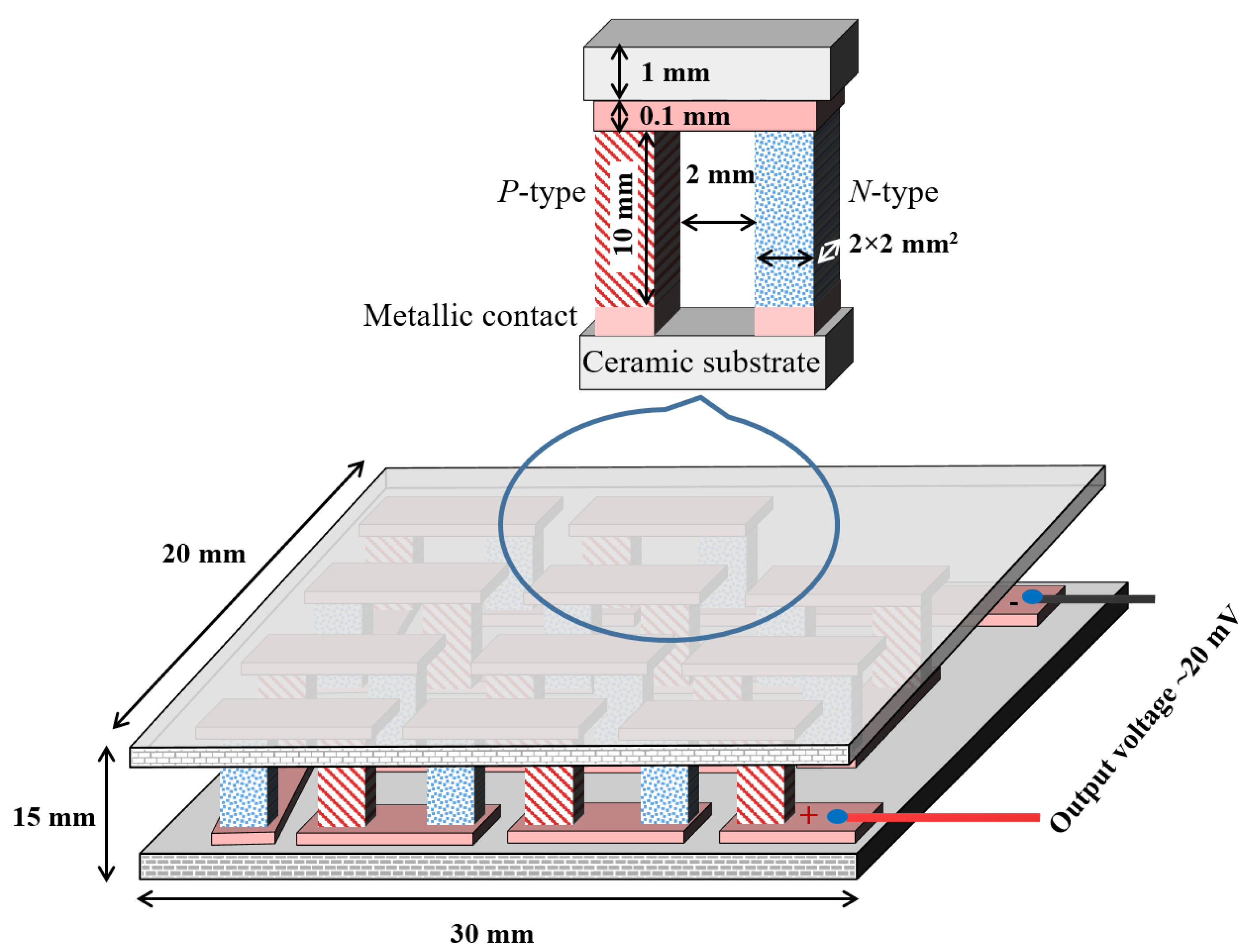
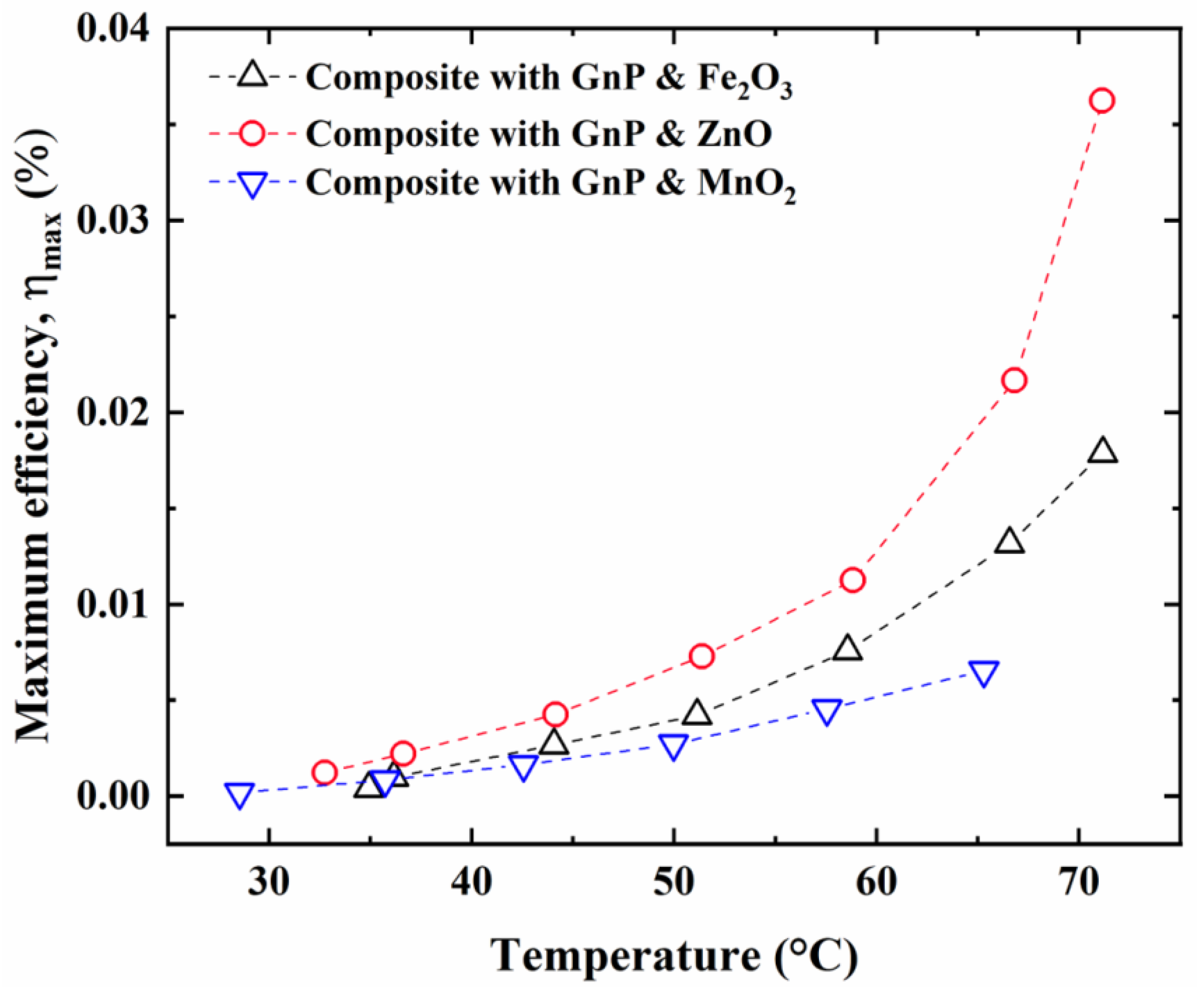
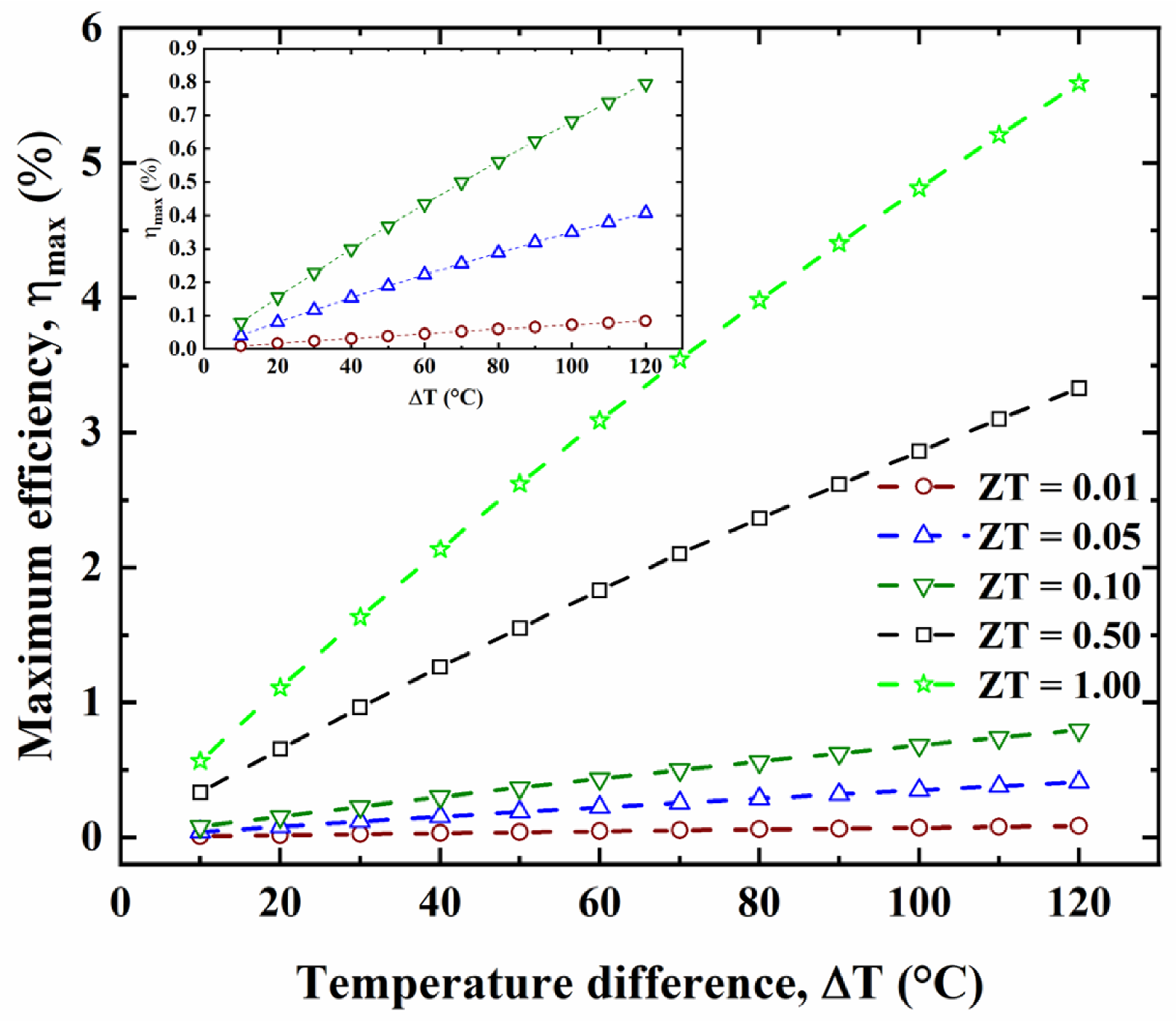
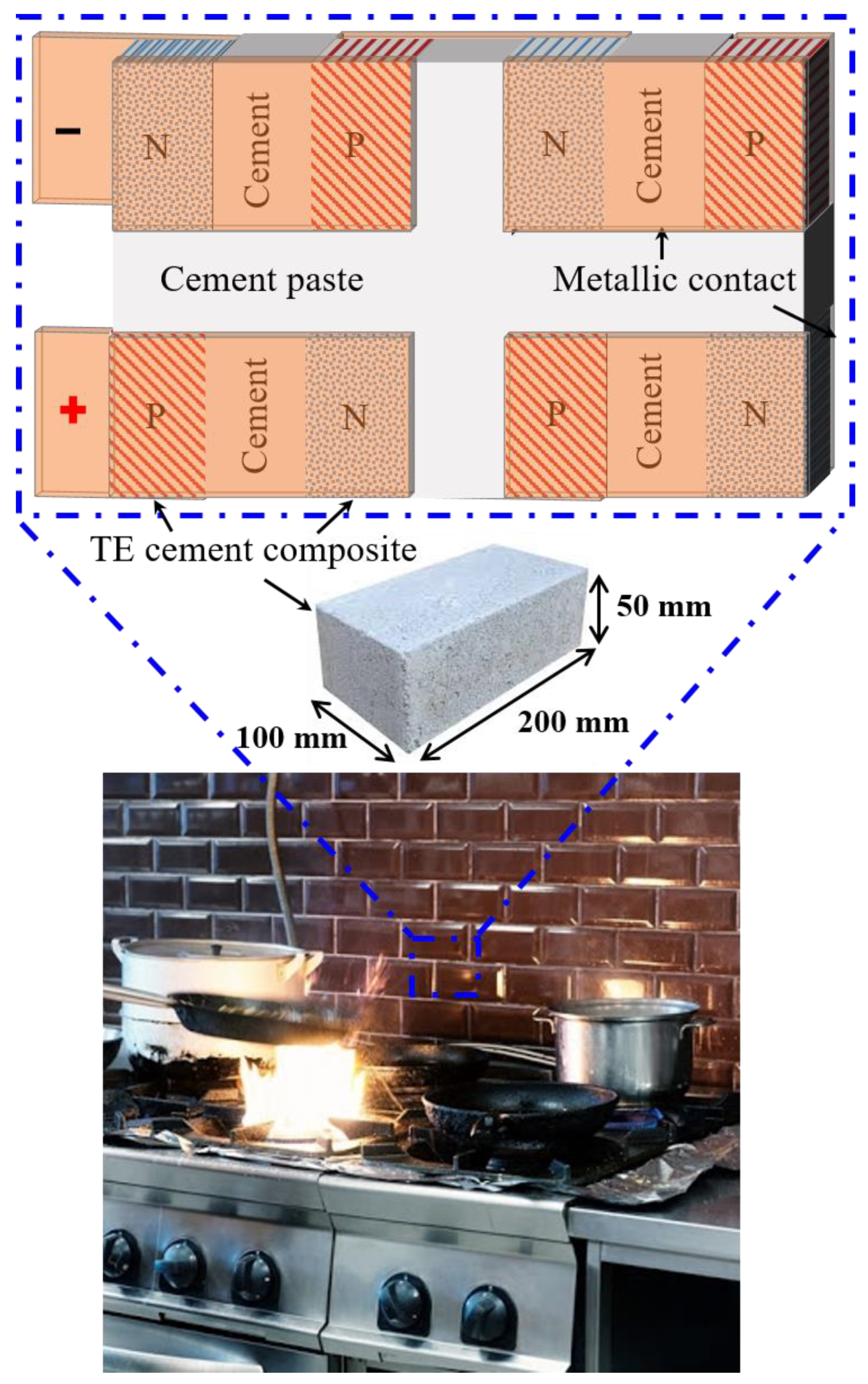
| Cement Composites Containing | Seebeck Coefficient, S (µVK−1) | Electrical Conductivity, σ (Scm−1) | Thermal Conductivity, κ (Wm−1K−1) | Figure of Merit, ZT, (×10−2) | Semiconduc-Tor Type |
|---|---|---|---|---|---|
| GnP | 30 | 11.6 | 0.94 | 0.028 | p |
| GnP-Fe2O3 | 105 | 8.5 | 0.66 | 0.5 | P |
| GnP-ZnO | 140 | 14.0 | 0.95 | 1.0 | p |
| GnP-MnO2 | 100 | 5.5 | 0.90 | 0.2 | p |
Disclaimer/Publisher’s Note: The statements, opinions and data contained in all publications are solely those of the individual author(s) and contributor(s) and not of MDPI and/or the editor(s). MDPI and/or the editor(s) disclaim responsibility for any injury to people or property resulting from any ideas, methods, instructions or products referred to in the content. |
© 2023 by the authors. Licensee MDPI, Basel, Switzerland. This article is an open access article distributed under the terms and conditions of the Creative Commons Attribution (CC BY) license (https://creativecommons.org/licenses/by/4.0/).
Share and Cite
Ghosh, S.; Saha, B.B. Estimation of Energy Harvesting by Thermoelectric Cement Composites with Nanostructured Graphene and Metallic Oxides. J. Compos. Sci. 2023, 7, 207. https://doi.org/10.3390/jcs7050207
Ghosh S, Saha BB. Estimation of Energy Harvesting by Thermoelectric Cement Composites with Nanostructured Graphene and Metallic Oxides. Journal of Composites Science. 2023; 7(5):207. https://doi.org/10.3390/jcs7050207
Chicago/Turabian StyleGhosh, Sampad, and Bidyut Baran Saha. 2023. "Estimation of Energy Harvesting by Thermoelectric Cement Composites with Nanostructured Graphene and Metallic Oxides" Journal of Composites Science 7, no. 5: 207. https://doi.org/10.3390/jcs7050207





